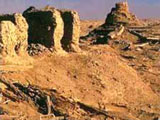 To the east of the Niya ruins is another world-famous city ruins, that of the Loulan Kingdom, which was swallowed up by the shifting sands of the Taklamakan Desert some 1,400 years ago. In this edition of On the Road we’ll continue our adventure in the lifeless desert and explore the ruins of the ancient Loulan Kingdom.
To the east of the Niya ruins is another world-famous city ruins, that of the Loulan Kingdom, which was swallowed up by the shifting sands of the Taklamakan Desert some 1,400 years ago. In this edition of On the Road we’ll continue our adventure in the lifeless desert and explore the ruins of the ancient Loulan Kingdom.
In the south of the Xinjiang Uygur Autonomous Region in northwest China lies the country’s largest inland basin, the Tarim Basin. It has been the home of 36 independent city states. However, as the Taklamakan Desert inexorably expanded, all the kingdoms were gradually swallowed by the shifting sand dunes, which can reach a height of 250 meters. Loulan was one of the kingdoms that lost this battle with nature.
The ruins of the kingdom are located on the western bank of Lake Lop Nur, in the northeast of the Tarim Basin. Once a vast lake in ancient times, today Lop Nur has entirely dried up. It is now a lake only in name.
Records of the Loulan Kingdom abound in major historical works in both China and the West of over 1600 years ago. Founded in the second century BC, Loulan was a sprawling kingdom of 360 thousand square kilometers whose domain bordered Dunhuang in the east and Niya city in the west. It had a population of over 14,000 people,and as a key traffic hub on the ancient Silk Road, it served as an important trading center between China and the West, welcoming streams of camel trains loaded with exotic goods from many parts of the world. Many of the visitors and caravans were from the Mediterranean region.
Loulan’s prosperity lasted for some 500 years, then, in the 5th century, it suddenly vanished from all recorded history without a trace. The rapid disappearance of such a large, prosperous kingdom, and even its exact whereabouts, were for centuries one of history’s major puzzles.
Then at the turn of the 20th century, the lost kingdom was brought into the light again when a Swedish adventurer named Sven Hedin was exploring the Lake Lop Nur area. Hedin accidentally discovered the ruins of the kingdom buried under the yellow sands of the Taklamakan Desert.
This historic discovery immediately stirred a great sensation worldwide. It set off a race of archaeologists, historians and explorers from all over the world to this site. Their excavations found more remains of buildings and a wealth of fascinating remnants of this lost civilization, including coins, wood carvings, lacquer and copper ware, silk fabrics, as well as numerous documents and splendid murals. They lifted the veil of the ancient kingdom and allow us to catch a glimpse of its splendid history and culture.
The ruins unearthed so far cover an area of over 100 thousand square meters, filled with the ruins of city walls, residential buildings, palaces, temples, workshops and towers, as well as broken beams and pillars littered here and there.
The most eye-catching architecture is a wooden Buddhist pagoda located in the east of the city ruins. This octagonal-shaped pagoda is ten meters in height, with a square base and a round top.
In the city center stand rows of houses which were built of adobe. They are surrounded by piles of wood. Some pieces of timber are five or six meters long. On the foundations of some of the houses we can still find traces of red paint. A large amount of historical documents have been discovered among these houses. Most of them are official files. Judging from these documents and the architectural design of the buildings, historians believe they were the kingdom’s government buildings.
In the west and south of the city are the residential quarters of the common folk. These houses were coated with straw and mud, and much more humble structures than the buildings in the center of the city.
A dried water tunnel runs through the city and divides it into two parts. Archaeologists have found that it’s connected to the traces of several former riverbeds outside the city, and was a key part of the water supply system for the people of Loulan.
You might be wondering where all the huge wooden beams I mentioned just now came from, for the nearest forests are far away from this arid desert region. The fact that there were once rivers here gives us a clue. Outside the city walls are the remains of what were once magnificent forests. Their trees have stood here for over two thousand years, although they have been dry and dead for many centuries. These signs of once vibrant life allow us to imagine the beauty of this oasis 1,500 years ago. Alas, we see how a world filled with water and greenery and energy has turned into a sea of sand and death.
Today, archaeologists and historians worldwide are still working hard to resolve the continuing mystery of this ancient kingdom. And, without doubt, the ruined city of the Loulan Kingdom is also a great place for tourists interested in both history and adventure to explore. However, be warned: the journey into the unforgiving wastes of the Taklamakan Desert is not for the faint of heart. But, what an experience!
(CRI October 9, 2002)
|

